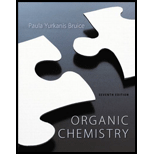
Concept explainers
(a)
Interpretation:
Whether the given solvent is protic or aprotic has to be indicated.
Concept Introduction:
Aprotic solvent:
An aprotic solvent is a solvent which can furnishes a proton in an aqueous solution.
Protic solvent:
A protic solvent is a solvent which can’t furnishes a proton in an aqueous solution.
(b)
Interpretation:
Whether the given solvent is protic or aprotic has to be indicated.
Concept Introduction:
Aprotic solvent:
An aprotic solvent is a solvent which can furnishes a proton in an aqueous solution.
Protic solvent:
A protic solvent is a solvent which can’t furnishes a proton in an aqueous solution.
(c)
Interpretation:
Whether the given solvent is protic or aprotic has to be indicated.
Concept Introduction:
Aprotic solvent:
An aprotic solvent is a solvent which can furnishes a proton in an aqueous solution.
Protic solvent:
A protic solvent is a solvent which can’t furnishes a proton in an aqueous solution.
(d)
Interpretation:
Whether the given solvent is protic or aprotic has to be indicated.
Concept Introduction:
Aprotic solvent:
An aprotic solvent is a solvent which can furnishes a proton in an aqueous solution.
Protic solvent:
A protic solvent is a solvent which can’t furnishes a proton in an aqueous solution.
Want to see the full answer?
Check out a sample textbook solution
Chapter 9 Solutions
Organic Chemistry; Modified MasteringChemistry with Pearson eText -- ValuePack Access Card; Study Guide and Student Solutions Manual for Organic Chemistry, Books a la Carte Edition (7th Edition)
- Hi, I need your help i dont know which one to draw please. I’ve attached the question along with my lab instructions. Please use the reaction from the lab only, as we are not allowed to use outside sources. Thank you!arrow_forward5. Write the formation reaction of the following complex compounds from the following reactants: 6. AgNO₃ + K₂CrO₂ + NH₄OH → 7. HgNO₃ + excess KI → 8. Al(NO₃)₃ + excess NaOH →arrow_forwardIndicate whether the product formed in the reaction exhibits tautomerism. If so, draw the structure of the tautomers. CO₂C2H5 + CH3-NH-NH,arrow_forward
- Draw the major product of this reaction N-(cyclohex-1-en-1-yl)-1-(pyrrolidino) reacts with CH2=CHCHO, heat, H3O+arrow_forwardDraw the starting material that would be needed to make this product through an intramolecular Dieckmann reactionarrow_forwardDraw the major product of this reaction. Nitropropane reacts + pent-3-en-2-one reacts with NaOCH2CH3, CH3CHOHarrow_forward
- Indicate whether the product formed in the reaction exhibits tautomerism. If so, draw the structure of the tautomers. OC2H5 + CoHs-NH-NH,arrow_forwardExplain how substitutions at the 5-position of barbituric acid increase the compound's lipophilicity.arrow_forwardExplain how substitutions at the 5-position of phenobarbital increase the compound's lipophilicity.arrow_forward
- Name an interesting derivative of barbituric acid, describing its structure.arrow_forwardBriefly describe the synthesis mechanism of barbituric acid from the condensation of urea with a β-diketone.arrow_forwardGiven the hydrazones indicated, draw the structures of the enamines that can be formed. Indicate the most stable enamine (explain). C6H5 C6H5 H C6H5 Harrow_forward
 Chemistry for Today: General, Organic, and Bioche...ChemistryISBN:9781305960060Author:Spencer L. Seager, Michael R. Slabaugh, Maren S. HansenPublisher:Cengage Learning
Chemistry for Today: General, Organic, and Bioche...ChemistryISBN:9781305960060Author:Spencer L. Seager, Michael R. Slabaugh, Maren S. HansenPublisher:Cengage Learning Organic ChemistryChemistryISBN:9781305580350Author:William H. Brown, Brent L. Iverson, Eric Anslyn, Christopher S. FootePublisher:Cengage Learning
Organic ChemistryChemistryISBN:9781305580350Author:William H. Brown, Brent L. Iverson, Eric Anslyn, Christopher S. FootePublisher:Cengage Learning

